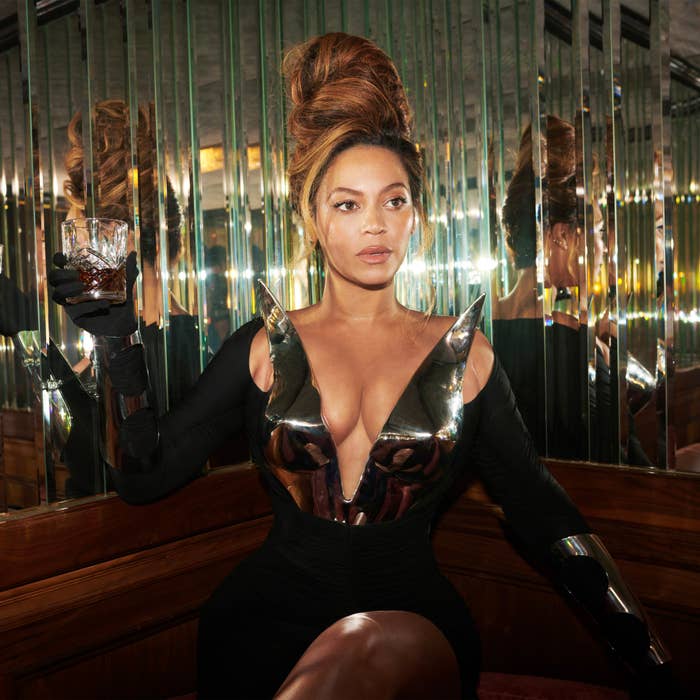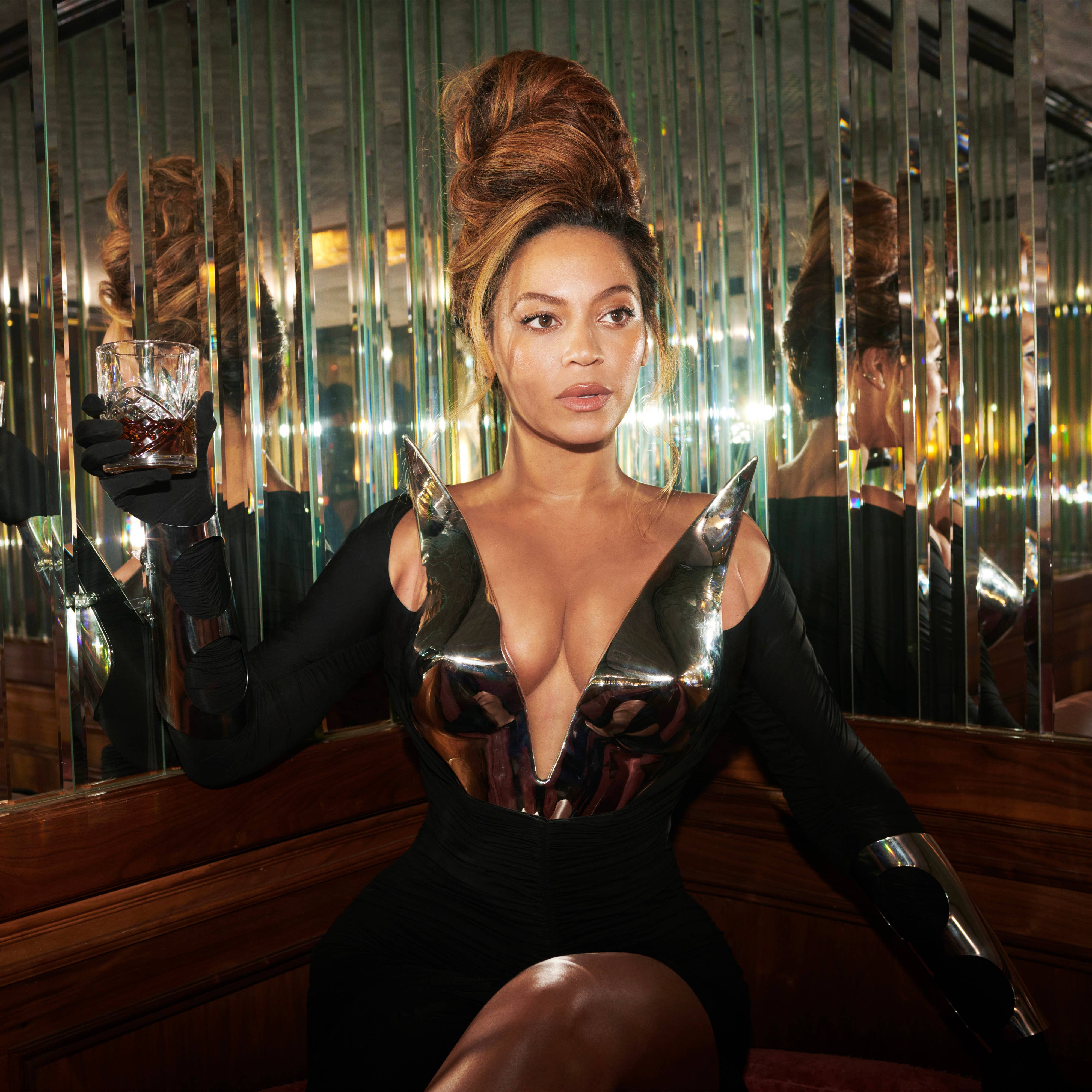
Beyoncé’s new album Renaissance is an immersion of dance, house, and soul music that captures that Friday-night-just-got-paid-anything-can-happen feeling. To achieve this, she paid homage to dance music history by sampling an impressive list of pioneers, from Robin S to Teena Marie and Donna Summer, while also presenting a fresh take for a new generation of fans.
More than just highlighting the evolution of dance, though, Renaissance also shows Beyoncé’s own evolution as an artist over the past two decades. She presents new ideas and themes centered around today’s current climate, but she’s been laying the foundation for many of these new songs for years. From her days in Destiny’s Child in the late ’90s, all the way up to 2016’s Lemonade, she’s been borrowing from various genres, trying out new flows, and refining her sound. Beyoncé is an artist who constantly evolves, and it’s her early work that helped build the cohesive sound of Renaissance.
As we continue to spin Beyoncé’s Renaissance, we looked back on her catalog and picked nine songs that helped inform the new album. These are songs that show some of her early forays into dance music, her first rap flows, and more. Presented in chronological order, the songs are below.
“No, No, No, Pt. 2” (1998)
View this video on YouTube
Album: Destiny’s Child
Producers: Wyclef Jean, Jerry Duplessis, Che Greene
Beyoncé the rapper has been showing up a lot in recent years, but the sing-rap flow we hear on Renaissance songs like “Thique,” “Cozy,” “Church Girl” is far from new. In fact, it can be traced all the way back to her days as a member of Destiny’s Child. In 2002, the group released This Is The Remix, an album of R&B and dance remixes from the group’s previously released albums. The standout “No, No, No, Pt. 2” is built around a hard-hitting bass line and a rhythmic beat, and it features an early sing-rap flow from Beyoncé, which helped set the stage for other rap moments in her career like “Video Phone” and “Upgrade U.” Over time, her flow has evolved into a more aggressive delivery on songs like “Top Off” and “Apeshit,” and it can all be traced back to early songs like “No, No, No, Pt. 2.”
“Baby Boy” (2003)
View this video on YouTube
Album: Dangerously In Love
Producers: Scott Storch, Beyoncé Knowles
“Baby Boy” is the second single from Beyoncé’s Dangerously In Love, and it’s one of the earliest instances of her experimenting with reggae and dancehall music. It’s a thumping song that features Jamaican dancehall rapper and singer Sean Paul. The beat, produced by Scott Storch, is based on the reggae record “Here Comes the Hotstepper,” which was performed by Kamoze in 1995 and centers around synthesized handclaps. “Baby Boy’s” influence shows up a few more times throughout Beyonce’s discography before Renaissance, which features songs like “Energy” and “Move” that draw inspiration from dancehall. Renaissance also lightly borrows from afrobeats, which Beyonce previously explored on the soundtrack for the The Lion King live-action film.
“Be With You” (2003)
View this video on YouTube
Album: Dangerously In Love
Producers: Rich Harrison, Beyoncé Knowles
“Be With You” is one of Beyoncé’s first songs that experimented with disco-era, funk sounds. The Dangerously In Love song slows things down, taking a sensual approach, as Beyoncé shows her vocal range and delivers soft, seductive notes over retro production. The sexiness that Beyoncé displayed on her debut album would show up again on songs like “Dance for You” and “Rocket,” before ultimately informing the sound of Renaissance standouts like the silky “Plastic Off the Sofa.”
“Get Me Bodied (Extended Mix)” (2006)
View this video on YouTube
Album: B’Day
Producers: Swizz Beatz, Sean Garrett, Beyoncé Knowles
Club and dance music has always been a part of Beyonce’s artistry, from Destiny’s Child’s “Jumpin, Jumpin” to “Crazy In Love” and beyond, but 2006’s “Get Me Bodied” is one of the most quintessential dance, club anthems in her discography. It embodies the youthful energy of the Y2K party scene, while also taking influence from old school “cookout” music and line-dancing. On the extended mix, Beyoncé leads us through a series of dance moves while still belting out powerful vocals. The call to action doesn’t show up quite as much on Renaissance, but songs like “Church Girl” are informed by the original idea. The song utilizes a soulful sample of The Clark Sisters, before erupting into a fun beat as Beyoncé instructs listeners to “Drop like a thotty” and “twirl that ass like you came up out the South girl,” which is reminiscent of the energy she had in 2006 on “Get Me Bodied.”
“Kitty Kat”
View this video on YouTube
Album: B’Day
Producers: The Neptunes, Beyoncé Knowles
When it comes to Beyonce’s best rap moments, you have to mention “Kitty Kat.” It’s an excellent example of Beyoncé’s duality as an artist, and an early display of her delivering a sing-rap flow and sensual vocals. It’s irresistibly sexy, while also representing one of Bey’s shining hip-hop moments, as she raps, “Got diamonds on my neck/ Got diamonds on my records/ Since 16 I was coming down riding Lexus/ How you gon neglect this? You is just a hot mess.” On Renaissance, we hear her perfect this sound on songs like “Cozy,” and the semi-hushed flow in parts of “Kitty Kat” shows up again on “Thique.”
“Love In This Club Part II” with Usher (2008)
View this video on YouTube
Album: Here I Stand
Producers: Soundz, Polo Da Don
“Love In This Club Part II” isn’t a Beyoncé song, but she does appear as a guest feature on the remix of Usher’s single, and her presence is certainly felt. It brought a new dimension to what was considered a “club anthem” in 2008, especially when many artists were still opting for uptempo, high-energy records. “Love In This Club Part II” is a slow-burning, seductive track that feels like it should be played in the privacy of your own home, but still has the appeal of a social, radio hit. Though the track does not appear on any of Beyoncé’s projects, its influence is clear on the new album. Renaissance is obviously a dance album, but that doesn’t necessarily mean that every song is made to twerk to. On tracks like “I’m That Girl” and “Plastic on the Sofa” we hear Beyoncé exploring ways to make slowed down songs that still inspire listeners to dance.
“Sweet Dreams” (2008)
View this video on YouTube
Album: I Am… Sasha Fierce
Producers: Wayne Wilkins, Jim Jonsin, Rico Love, Beyoncé Knowles
“Sweet Dreams” is an electro-pop track with rock and funk influences. The track utilizes groovy instrumentation and sounds like a distant cousin to Michael Jackson’s 1983 single “Beat It.” Electric and funky records have always snuck their way into Beyoncé’s discography, especially during her Sasa Fierce era. The groovy texture of “Sweet Dreams”connects to Renaissance songs like “America Has A Problem” and “Virgo’s Groove.” The tone of both “Sweet Dreams” and “America Has A Problem” are similarly ominous, and although they don’t center around the same subject matter, both messages suggest everything is not as good as it seems.
“Blow” (2013)
View this video on YouTube
Album: Beyoncé
Producers: Pharrell Williams, Timbaland, J-Roc, Beyoncé Knowles
A lot of the songs on Renaissance sound as if they were created with 2013’s “Blow” in mind. The funky, disco-inspired track is reminiscent of ’70s and ’80s R&B and funk, best performed by artists like Prince and Janet Jackson at the time. Today, some would categorize it as roller-skating music. The style showed up much earlier in Beyoncé’s discography, like on 2006’s “Green Light,” but “Blow” is where she perfected the sound. On Renaissance, the addictive electro-soul sound is present throughout the tracklist, but it’s heard most clearly on a song like “Cuff It.” The intro of “Cuff It,” especially, is very similar to “Blow,” and it has the same retro, electric-funk that compels listeners to the dance floor.
“Flawless” (2013)
View this video on YouTube
Album: Beyoncé
Producers: Hit-Boy, Boots, Rey Reel, HazeBanga, Beyoncé Knowles
“Flawless” is another great example that shows the evolution of Beyoncé’s rap-singing flow, and her attitude on the song is present on much of Renaissance. It’s a cocky and unapologetic record that features one of Beyoncé’s most blatant displays of ego and self-confidence in her entire catalog, reeking of braggadocio as she talks about her diamonds, beauty, and husband. The attitude on “Flawless” (as well as “Bow Down/ I Been On”) rubbed some listeners the wrong way, but it’s ultimately intended to be an empowering anthem. As Beyoncé’s starpower has grown, she’s been more open to acknowledging her influence and power on wax, and this shows up on Renaissance’s opening track “I’m That Girl” as she raps, “Please, motherfuckers ain’t stoppin me,” before declaring, “I’m just that girl.” Beyonce also talks that talk on “Thique,” rapping over Hit-Boy production, “Ass getting thicker/ Cash getting thicker/ Cash getting larger.” Renaissance is an extremely confident album, and that attitude can be tied back to early songs like “Flawless.”










